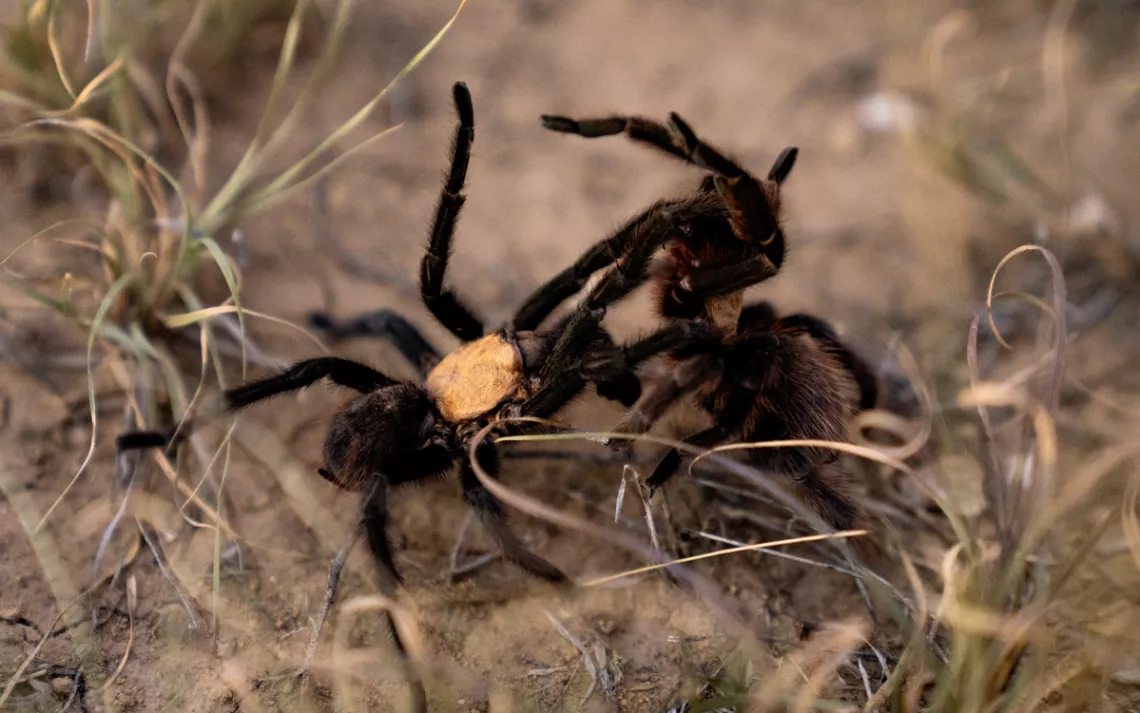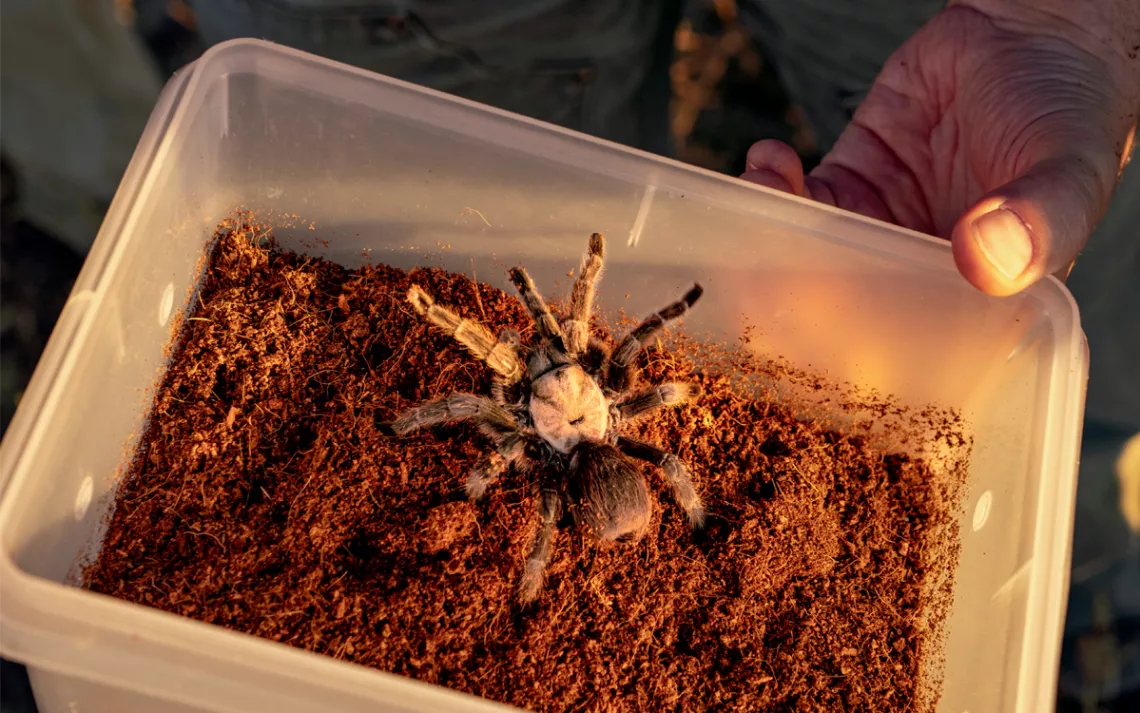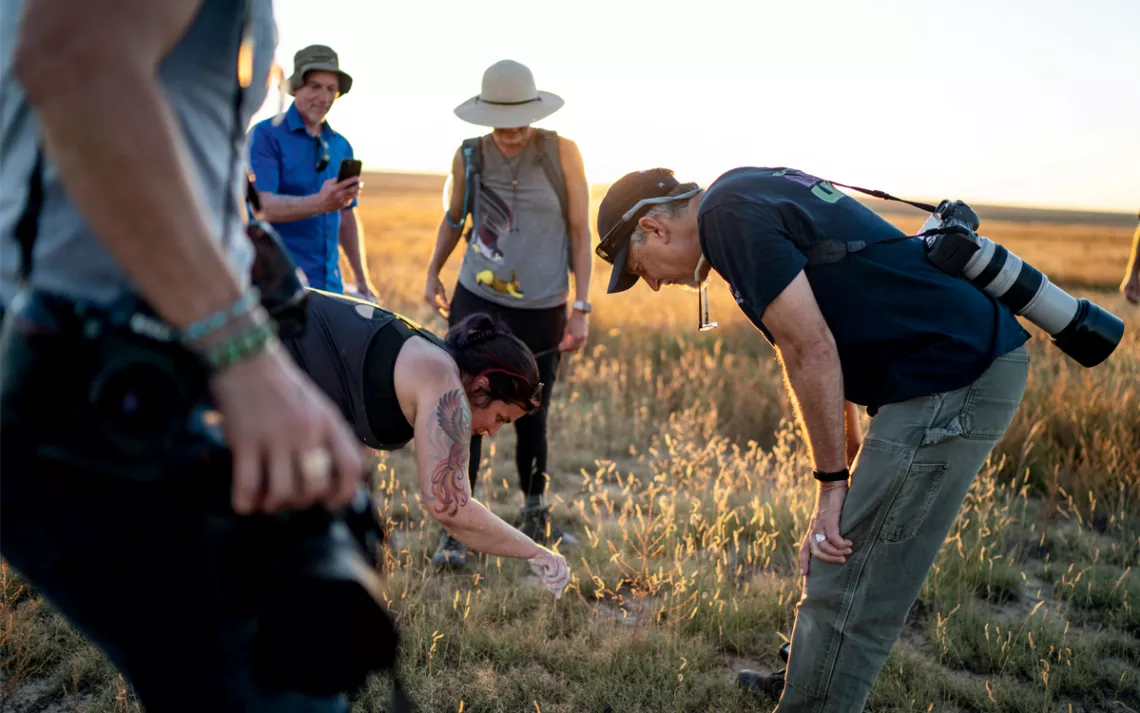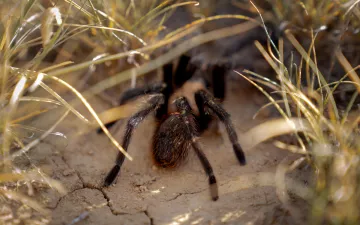In Search of the Tarantula "Mate-Gration"
Researchers dig for the secrets of arachnids in Colorado

Tarantulas mating looks a lot like tarantulas wrestling. | Photo by Brendan Davis
In 2020, stir-crazy from months of quarantine, two friends and I waved goodbye to our families and set out on a quest to see wild tarantulas—because why not? Two hours southeast of Denver, cholla cacti began to appear like twisted candelabras, their yellow seedpods bright against the blue sky. Buckwheat and grama grasses waved above prickly pear and broom snakeweed. Irrigated cropland, still in the rain shadow of the Rocky Mountains, was full of late-season melons and pumpkins.

A female tarantula waits in a plastic tub while researchers make a cast of her burrow.
It was 103°F when we arrived at the Timpas Unit of the Comanche National Grassland, just south of the town of La Junta, Colorado, where every year in September thousands of male Oklahoma brown tarantulas, Aphonopelma hentzi, wander, hoping to mate with as many females as they can.
We searched for hours, red-faced and sweaty. We followed the bright-orange flash of tarantula hawks: parasitic wasps that hunt the arachnids. We were fooled by some tarantula-size rocks. We didn't see any tarantulas that first year, but we camped under stars as bright as we'd ever seen and fell in love with the grasslands. We've gone back every year since. We call it "tarantula camp."
"He's trying to make slam dunks into a fanny pack and hold her up and not get eaten, all at once."
For years, the press has called this tarantula phenomenon a "migration," and in 2018 the La Junta tourism board branded it the Tarantula Trek. Those terms aren't accurate—the Oklahoma browns' range extends from Colorado to Texas and as far east as Louisiana, but an individual male rarely travels more than a kilometer from his birthplace. Rich Reading, vice president of science and conservation at the Butterfly Pavilion in Westminster, Colorado, calls it a "mate-gration."
In late September 2022, I joined Reading and Jackie Billotte, a PhD candidate at Colorado State University, at the Southern Plains Land Trust, which is adjacent to the Timpas Unit. They planned to take the first known plaster of paris casts of the interiors of female tarantula burrows. Tarantulas, like all invertebrates, are woefully understudied, and the scientists hope to better understand how they survive in the area's harsh conditions.
Billotte is friendly, tattooed, endlessly enthusiastic. "It's kind of the Wild West of tarantulas out there," she said when I asked what drew her to the work. "Having a big field of questions to ask is a good thing, but I also think the tarantulas are kind of cute."

Jackie Billotte and Rich Reading lure female tarantulas out into the open.
Female tarantulas move even less than males, living in burrows near their birthplace for their entire lives. Billotte instructed us to spread out and search for quarter-size holes, possibly web-covered. This was harder than it sounds, but I did manage to spot a male. I followed him for a while. We were looking for the same thing, after all.
He delicately picked his way along. He was about the size of my hand—smaller than a female, with an abdomen that was the same dark brown as his legs and a light-tan cephalothorax. He was fuzzy and slow and gentle, seemingly unbothered by the human presence. Like everything in the grasslands and the canyons that wind through them, the tarantulas' beauty feels fragile and rare, almost magical.
Drivers are advised to use caution on area highways this time of year. Despite the official warnings, road mortality is high during mating season, the corpses easily visible on the asphalt. Reading is lobbying the state to build underpasses at high-density road crossings for safe passage. Other small grassland creatures could benefit, but Reading's focus is on the tarantulas.
Tarantulas are a crucial part of the grassland ecosystem. As generalist predators, they eat almost all other invertebrate species and have been known to eat snakes, mice, voles, lizards, frogs, and toads. Tarantula hawk wasps, their main predator, are essential pollinators—at risk of disappearing without the tarantulas as their hosts. Badgers eat the spiders, as do coyotes. One of the researchers' most surprising findings so far is that tarantula populations are healthier on heavily grazed sections of land.
A male tarantula reaches sexual maturity around age seven. New emboli form at the end of his pedipalps—sensory appendages that look like a spare set of legs—bulbing out like tiny clubs. He uses them to tap lightly at the entrance of a female's burrow. It's a restrained mating dance, something close to polite knocking. "He's letting her know, 'I'm not food. I'm here for something else,'" Billotte said, adding that it's a good sign if the female taps back.
Another marker of male sexual maturity is that his first pair of legs grow tibial hooks. No matter how polite the male tarantula is, after the pair mate, the female will almost certainly try to eat him. During copulation, the hooks keep the female at bay while the male creates a series of sperm webs, which he works to insert into the female's epigynum, located on the top of her abdomen. Billotte described it this way: "He's trying to make slam dunks into a fanny pack and hold her up and not get eaten, all at once."
The mating pair we found later looked like wrestlers locked in a bear hug. "Are we about to witness a murder?" I asked. Not even the scientists knew the odds, as the rates of sexual cannibalism have not been closely studied. We all cheered when the male escaped. He would continue his quest to leave as much of a genetic legacy as possible before he inevitably died at the end of the season. The tibial hooks that protect him during mating also prevent him from molting, which is always fatal.
Reading showed us how to "fish" for the females by tapping at their burrow entrances with a long-stemmed grama seed head. Once I found a burrow, I worked to channel his patience and persistence through several frustrating failed attempts. It seemed to take forever, but finally the female grabbed the other end of my grass stem and pulled. It was thrilling. When the resulting game of tug-of-war lured her out into the open, I blocked the burrow entrance with my boot, as I'd been instructed. Reading scooped the tarantula into a plastic box with air holes and set her next to the others, then Billotte got to work pouring plaster into the spider burrow.
A light breeze rattled a patch of dried yucca blooms and set the yellowing grasses to swaying. Despite the heat, despite the relentless sun, summer was fading. When the casts were set and dug, they looked like funky plumbing, each pipelike cast misshapen in different ways, ranging from 18 inches to almost two and a half feet long. Billotte took soil samples near each one, and the scientists tenderly released the females near their former burrows. As though we hadn't disturbed them at all, the tarantulas patiently started the work of rebuilding. In no time, the scientists reassured us, they would be safely underground again.
See for Yourself
Here are a few tips for finding (and being a friend to) these charming creatures.

Be Prepared
The Timpas Unit (and many other tarantula habitats) are prone to harsh, unpredictable weather. The signage at the Vogel Canyon trailhead lists symptoms of heat stroke and heat exhaustion under the warning: "Caution! Hiking into the canyon is optional. Hiking out is mandatory!" Temperatures can drop close to freezing without much warning, and the area is sparsely populated. Be sure you have supplies to self-rescue in case of hiking mishaps or vehicle trouble.
Watch the Road
After failing to see a single tarantula in our first year in the Timpas, we later discovered that we could most reliably spot them by driving remote roads at dusk. Rich Reading confirmed that this strategy gave us the best chance of a sighting. Follow all traffic rules and pull all the way off the road if you stop to observe.
Let Them Be
Each year during mating season, people collect adult males from the wild as pets. Not only are these tarantulas weeks away from certain death, but it has taken them years to reach mating age. Wild adults are survivors—especially well-adapted individuals with phenotypes that a healthy local population needs. Pet tarantulas should be sourced only from ethical breeders.
 The Magazine of The Sierra Club
The Magazine of The Sierra Club



